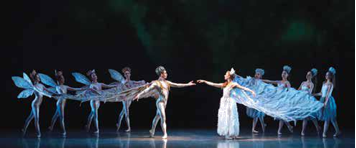A Midsummer Night’s Dream
Kara Pickman

Miami City Ballet dancers in A Midsummer Night’s Dream. Choreography by George Balanchine © The George Balanchine Trust. Photo © Gene Schiavone
march 18–April 10, 2016
As part of the company’s 30th-anniversary season, the Miami City Ballet debuted its distinct reimagining of George Balanchine’s 1962 two-act A Midsummer Night’s Dream, the choreographer’s first original full-length ballet. Interestingly, Balanchine created the main role of Oberon for Edward Villella, the Miami City Ballet’s founding artistic director.
Under the leadership of current artistic director Lourdes Lopez and with dramatic direction by Tarell Alvin McCraney, the spare staging brings Oberon, Hippolyta, Puck, and the rest of the Athenians and fairies out of the woodland and underwater.
This concept, and the scenery and costume design, are brought to life by artist Michele Oka Doner. While New York–based, Oka Doner is a Miami Beach native, and her work—concurrently on view in the exhibition Michele Oka Doner: How I Caught a Swallow in Midair at Pérez Art Museum Miami—tends to return to the flora and fauna of her native Florida.
When approached by Lopez about the A Midsummer Night’s Dream collaboration, Oka Doner made a connection between the ballet and her recent research at the Rosenstiel School of Marine Biology at the University of Miami, where she was able to comb through their unique collection of nearly one million marine life species that can be found in South Florida’s tropical waters.
Many such specimens are translated to the stage in this new production, to alternatingly humorous and lustrous effect: the donkey Bottom (Didier Bramaz) becomes a large-headed manatee, Puck (Shimon Ito)—still traditionally impish and delightful—wears what appears to be woven strands of seaweed, and Hippolyta’s (Jordan Elizabeth Long) hounds are transformed into seahorses.
While these underwater themes, the subdued, shimmering pallete, and the Coral Castle–like architecture of Act II may resonate with Miamians, undoubtedly the dancers retain their place at the center of this ballet’s universe—be it of the woods or of the sea.
In fact, the nautical staging works to lighten the traditional wooded setting, so that less attention is placed on the dancers’ surroundings and, instead, due emphasis is placed on the dancers themselves. The subdued lyracism of Oka Doner’s designs plays off the dancers’ own, creating an unparalleled production of a classical work that, in this iteration, is truly Miami’s own.









